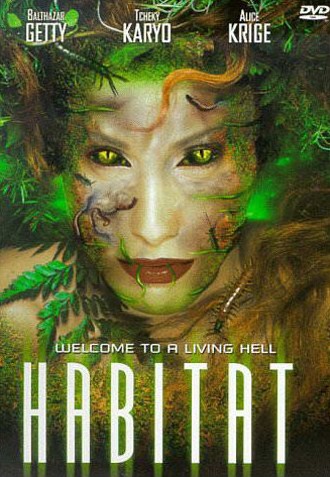 A key film of writer-director Rene Daalder, Canada’s answer to American grade-B auteurs like Larry Cohen and Jack Hill. A quasi-science fictionish account of monstrous vegetation and biological mutation, the film contains many interesting concepts but is crippled by (among other things) a ridiculously low budget.
A key film of writer-director Rene Daalder, Canada’s answer to American grade-B auteurs like Larry Cohen and Jack Hill. A quasi-science fictionish account of monstrous vegetation and biological mutation, the film contains many interesting concepts but is crippled by (among other things) a ridiculously low budget.
The Dutch-bred Rene Daalder is best known for the 1976 exploiter MASSACRE AT CENTRAL HIGH, a film marked by audacious concepts and frankly crappy execution. The same can be said for HABITAT, which was not a success upon its 1997 release but has attained a minor cult following, with the out of print DVD currently selling for exorbitant sums on the internet.
Sometime in the future global warming has turned the Earth into a parched wasteland. Hank Symes, a biological scientist, is looking to save the planet through “accelerated evolution,” accomplished via mutated plants. Hank moves to a spiffy suburban townhouse together with his wife Clarissa, teenage son Andreas and retinue of genetically engineered vegetation. One day while Clarissa and Andreas are out Hank has an accident in his basement lab that causes the vegetation to grow out of control.
Before long the house is suffused with unearthly plants that inevitably claim a human victim: Hank himself, who literally vanishes into a puff of green mist. This leaves Clarissa and Andreas to subside in an increasingly tropical environ, with food provided by plant scrapings–as Clarissa claims, “Our food does not have a shelf life, it lives on the shelf.”
Hank still exists as a particle swarm, and as such causes odd sores to break out all over the body of one of Andreas’ friends, while his coach has a violent allergic reaction upon setting foot in the house. Andreas himself evinces some bodily oddities, such as the fact that his skin doesn’t seem to burn when exposed to direct sunlight.
Eventually Hazmat suit wearing guys invade the house, which is just what Hank, in his new subhuman form, wants. Mass bloodletting and physical mutation are in store.
This being a Rene Daalder movie, the muddy lighting and high school play-worthy art direction are to be expected. So too the wooden dialogue, overwrought score and primitive CGI.
Intelligence and audacity are Daalder’s real (and only) strengths. I’m not sure he ever succeeds in imparting a coherent ecological statement, but Daalder does conjure some striking David Cronenberg worthy grotesquerie. His terrifically fecund ideas, unfortunately, aren’t done justice by the painfully low budget and bland filmmaking (a complaint that tends to recur with Daalder’s movies).
A further problem is the mutated Hank’s third act appearance as a Tinkerbell-esque dancing beam of light, a silly idea that should have been rethought. Also, too much of the narrative is lavished on Andreas’ problems with the school bullies and his bland courtship with the coach’s daughter (Laura Harris of THE FACULTY).
There are at least some strong performers in the cast, including the always-game Alice Krige (fresh off her signature role as the Borg Queen in STAR TREK: FIRST CONTACT) and the French accented Tcheky Karyo. Both deserve a better movie.
Vital Statistics
HABITAT
Transfilm Kinsborough Pictures Ectopia B.V.
Director: Rene Daalder
Producers: Claude Leger, Pieter Kroonenberg
Screenplay: Rene Daalder
Cinematography: Jean Lepine
Editing: Gaetan Huot
Cast: Balthazar Getty, Alice Krige, Tcheky Karyo, Kenneth Walsh, Laura Harris, Brad Austin, Christopher Heyerdahl, Chris Holdenfried, Daniel Pilon, Bruce Mackay
